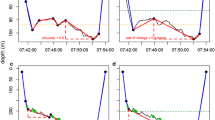Abstract
The under-ice behavior of two free-ranging female Weddell seals (Leptonychotes weddellii) was studied using geomagnetic, acceleration and velocity sensors at Big Razorback Island in McMurdo Sound, Antarctica. The seals' body angle and posture were calculated from the acceleration data and the heading from the geomagnetic intensity data. Together with swim speed, the seals' three-dimensional underwater dive path, heading and even posture were reconstructed for each dive. Each instrument was deployed for 2 days, during which time these females made multiple, deep (≥50 m) dives, with average maximum depths of 236±27 m (n=4) and 244±121 m (n=40). Each seal appeared to choose a particular heading on which to descend. These headings were significantly different between seals and bouts (Watson's U 2 test, P<0.05). These new instruments and methodologies are shown to provide valuable information on the fine-scale and complex movements of diving animals.







Similar content being viewed by others
References
Burns JM, Trumble SJ, Castellini MA, Testa JW (1998) The diet of Weddell seals in McMurdo Sound, Antarctica as determined from scat collections and stable isotope analysis. Polar Biol 19:272–282
Davis RW, Fuiman LA, Williams TM, Collier SO, Hagey WP, Kanatous SB, Kohin S, Horning M (1999) Hunting behavior of a marine mammal beneath the Antarctic fast ice. Science 283:993–996
Davis RW, Fuiman LA, Williams TM, Le Boeuf BJ (2001) Three-dimensional movements and swimming activity of a northern elephant seal. Comp Biochem Physiol A 129:759–770
Fuiman LA, Davis RW, Williams TM (2002) Behavior of midwater fishes under the Antarctic ice: observation by a predator. Mar Biol 140:815–822
Green K, Burton HR (1987) Seasonal and geographical variation in the food of Weddell seals, Leptonychotes weddellii, in Antarctica. Aust Wildl Res 14:475–489
Harcourt RG, Hindell MA, Bell DG, Waas JR (2000) Three-dimensional dive profiles of free-ranging Weddell seals. Polar Biol 23:479–487
Hindell MA, Harcourt R, Waas JR, Thompson D (2002) Fine-scale three-dimensional spatial use by diving, lactating female Weddell seals Leptonychotes weddellii. Mar Ecol Prog Ser 242:275–284
IAGA, Division V, Working Group 8 (2000) International geomagnetic reference field—2000. Phys Earth Planet Inter 120:39–42
Kooyman GL (1968) An analysis of some behavioral and physiological characteristics related to diving in the Weddell seal. Antarct Res Ser 11:227–261
Kooyman GL, Gentry RL, Urquhart DL (1976) Northern fur seal diving behavior: a new approach to its study. Science 193:411–412
Kusagaya H, Sato K (2001) A safe and practical inhalation anaesthesia for Weddell seals. Polar Biol 24:549–552
Le Boeuf BJ, Naito Y, Huntley AC, Asaga T (1989) Prolonged, continuous, deep diving by northern elephant seals. Can J Zool 67:2514–2519
Naito Y, Le Boeuf BJ, Asaga T, Huntley AC (1989) Long-term diving records of an adult female northern elephant seal. Antarct Rec 33:1–9
Sato K, Mitani Y, Cameron MF, Siniff DB, Watanabe Y, Naito Y (2002) Deep foraging dives in relation to the energy depletion of Weddell seal (Leptonychotes weddellii) mothers during lactation. Polar Biol 25:696–702
Sato K, Mitani Y, Cameron MF, Siniff DB, Naito Y (2003) Factors affecting stroking patterns and body angle in diving Weddell seals under natural condition. J Exp Biol (in press)
Simpkins MA, Kelly BP, Wartzok D (2001) Three-dimensional analysis of search behaviour by ringed seals. Anim Behav 62:67–72
Stirling I (1966) A technique for handling live seals. J Mammal 47:543–544
Tanaka H, Takagi Y, Naito Y (2001) Swimming speeds and buoyancy compensation of migrating adult chum salmon Oncorhynchus keta revealed by speed/depth/acceleration data logger. J Exp Biol 204:3895–3904
Wilson RP, Wilson MP (1988) Dead reckoning: a new technique for determining penguin movements at sea. Meeresforschung 32:155–158
Wilson RP, Wilson MP, Link R, Mempel H, Adams NJ (1991) Determination of movements of African penguins Spheniscus demersus using a compass system: dead reckoning may be an alternative to telemetry. J Exp Biol 157:557–564
Yoda K, Naito Y, Sato K, Takahashi A, Nishikawa J, Ropert-coudert Y, Kurita M, Le Maho Y (2001) A new technique for monitoring the behaviour of free-ranging Adélie penguins. J Exp Biol 204:685–690
Zar JH (1984) Circular distributions: hypothesis testing. Biological analysis, 2nd edn. Prentice-Hall, Englewood Cliffs, NJ, pp 440–469
Acknowledgements
We thank C. Counard, S. Dahle, D. MacNulty, K. Krysl, H. Reider, E. Morton, and G. Wong for their assistance with the fieldwork. We are also grateful to H. Tanaka, S. Minamikawa, and C. Tsushima for the propeller calibration experiments. The experimental protocol was previously approved by the National Marine Fisheries Service, Marine Mammal Protection Agency. The fieldwork was conducted at McMurdo Station of the United States Antarctic Program. This work was partly supported by a Grant-in-Aid from the Japan Society for the promotion of Science (11691197 and 14405027), the Sasakawa Scientific Research Grant from the Japan Science Society (14-368M), and the National Science Foundation (OPP-9420818).
Author information
Authors and Affiliations
Corresponding author
Rights and permissions
About this article
Cite this article
Mitani, Y., Sato, K., Ito, S. et al. A method for reconstructing three-dimensional dive profiles of marine mammals using geomagnetic intensity data: results from two lactating Weddell seals. Polar Biol 26, 311–317 (2003). https://doi.org/10.1007/s00300-003-0487-y
Received:
Accepted:
Published:
Issue Date:
DOI: https://doi.org/10.1007/s00300-003-0487-y




